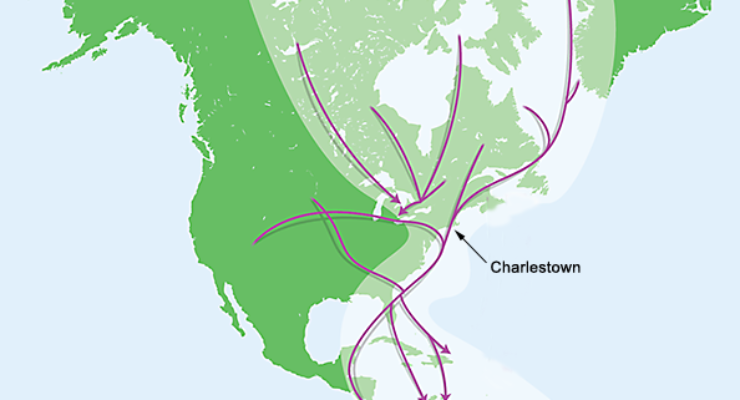CCA Works To Protect Migratory Bird Habitat
The following letter appeared in local newspapers and is reprinted here with permission of the author Ruth Platner. Ruth is a member of the Charlestown Planning Commission.
Charlestown is an important stopover in the Atlantic Flyway, the main migration route for birds along the east coast – and the spring bird migration has begun! In mid-February, radar captured a surge of thousands of migrating birds leaving Cuba and landing in Florida. Many of those birds will start to arrive in Charlestown soon.
Spring birdsong elevates nearly everyone’s mood, but will our woods and shore be a little quieter this spring? Since 1970, North America has lost 3 billion breeding adult birds from the total bird population. Across the continent, that’s one in four birds gone. For shore birds and all birds in the Atlantic Flyway things are even worse with one in three birds gone.
These declines were published last year in the journal Science. According to the paper’s authors, these bird losses are a strong signal that our human-altered landscapes are losing their ability to support bird life. Habitat loss is considered to be the main cause of bird declines. Loss of maritime shrubland is one of those disappearing habitat types that are contributing to the rapid decline in bird populations.
The swath of land along the Atlantic Flyway contains more than a third of the human population of the United States. Along the coast these are highly developed areas with little habitat for birds to rest and feed. Charlestown’s Ninigret National Wildlife Refuge offers migrating birds the first true respite, darkness and a gateway to miles of relatively unfragmented open space on their journey north. In the fall it offers a place to rest and fatten up before embarking on this same path south along an urban coastline.
The numbers of birds migrating through Charlestown is significant. The bird banding station at the refuge has the highest counts of any banding station in New England, with a very high proportion of young birds making their first migration.
Maritime shrubland habitat is scarce, but the refuge’s patch is hundreds of acres in size and is one of the largest stands of this habitat on the coast. Migrating birds arrive at the refuge exhausted and thin. Without the rest and food that the refuge provides, these birds are much less likely to survive.
Ninigret National Wildlife Refuge is permanently protected, but more intense development on nearby public land and thoughtless destruction of forests and shrubland elsewhere will chip away at the value of the refuge to those species it was created to protect.
The Charlestown Citizens Alliance endorsed members of the Town Council and Planning Commission have worked to protect the viability of the refuge as a place for birds to rest on their increasingly challenging migrations, and it is important that we continue to maintain and protect this habitat that is key to the maintenance of songbird populations.

You can learn more about the author, Ruth Platner, at her profile page.

March 11, 2020 @ 10:26 am
All the more reason to love Charlestown!!!!